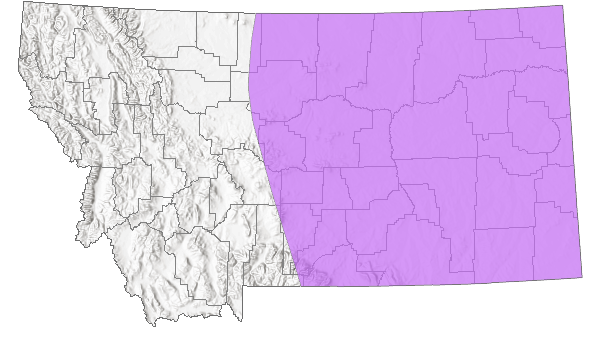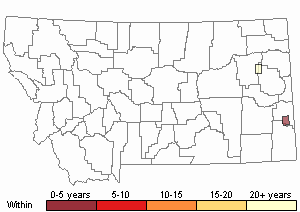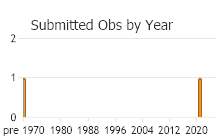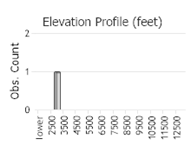View in other NatureServe Network Field Guides
NatureServe
Montana
Utah
Wyoming
Idaho
Wisconsin
British Columbia
South Carolina
Yukon
California
New York
Haldeman's Grasshopper - Pardalophora haldemanii
General Description
The following is taken from Hebard (1928), Brooks (1958), Helfer (1971), Otte (1984), Vickery and Kevan (1985), McDaniel (1987), Bland (2003), Capinera et al. (2004), Brust et al. (2008). Note: The early literature places this species in the genus Hippiscus. This is a large, light brown to gray grasshopper with extensive dark spotting. The dorsal pronotum (thorax) is flat and heavily sculpted with tubercles which tend to form ridges parallel to the posterior margin. The carina (ridge) is low, distinct, and incised with a sulcus (cut) well forward of the middle. Viewed dorsally, the pronotum is narrow anteriorly and widens posteriorly beyond the sulcus. The tegmina (forewings) bear numerous dark spots. The hindwing disks can be red, orange, or yellow; bordered with a black band and a long spur; the outer edge is transparent. The inner face of the hind femur is unicolorous (no markings) and can be red, orange, or yellow, except for a dark brown crescent at the knee. The hind tibia can be red, orange, or yellow.
Communicative behavior/Crepitation*
Femur-tipping and femur-shaking are the only signals given in this species. During courtship, the males also strike the apical ends of their hind tibias against the ground, producing an audible drumming that can be heard several feet distant. In male aggression encounters, femur-tipping is the main signal, femur-shaking is rare. Crepitation and stridulation* are absent in this species (Otte 1970, and Vickery and Kevan 1985).
*Crepitation is the sound produced by grasshoppers making a clicking or snapping noise with their wings when in flight, during courtship, territorial encounters or being disturbed.
*Stridulation is rubbing one body part against another, usually the hind femur against the forewing in the case of the Band-winged Grasshoppers. This is often used for attracting a female during courtship (Otte 1970).
Phenology
The Haldeman’s Grasshopper overwinters in the 3rd and 4th instar stages in the northern latitudes. Adults occur from mid-June to late August, with their greatest abundance during late-June and early-July (Otte 1984, McDaniel 1987, Brust et al. 2008, and Scott 2010).
Diagnostic Characteristics
The following comes from Hebard (1928), Brooks (1958), Helfer (1971), Otte (1984), Vickery and Kevan (1985), McDaniel (1987), Bland (2003), Capinera et al. (2004), Brust et al. (2008), and Scott (2010). The body length for males is 31-38 mm, and for females 42-53 mm. The females are significantly larger than males.
This species can be confused with its congener,
Coral-winged Grasshopper (
Pardalophora apiculate). The forewing spotting arrangement easily separates them (refer to that species for comparison). This species is also the only grasshopper in having a unicolorous inner face hind femur (Otte 1984).
Species Range
Montana Range
Range Descriptions

 Native
Native
Range Comments
This species occurs from Michigan, westward across the Great Plains to Montana, the eastern half of Wyoming, Colorado, and portions of Utah and New Mexico. From the north in southern Manitoba, southward to Texas. In Montana, it has been reported for 5 counties (Otte 1984, Vickery and Kevan 1985, and Scott 2010).
Observations in Montana Natural Heritage Program Database
Number of Observations: 2
(Click on the following maps and charts to see full sized version)
Map Help and Descriptions
Relative Density

Recency



 (Observations spanning multiple months or years are excluded from time charts)
(Observations spanning multiple months or years are excluded from time charts)
Habitat
Inhabits mostly grasslands, pastures, and open grassy areas. Seldom occurs in tall grass and weedy habitats (Otte 1984, Vickery and Kevan 1985, and Brust et al. 2008).
Food Habits
The Haldeman’s Grasshopper is a grass feeder, with little preference for any particular species (Vickery and Kevan 1985, Brust et al. 2008).
Reproductive Characteristics
To date, femur-tipping, femur-shaking and audibly striking the ground with the hind tibia are the only signals used by courting males. The nymphs pass through 5 instar stages before reaching the adult stage. Beyond these observations, there are no other reproductive details reported in the literature (Otte 1984, and Vickery and Kevan 1985).
Stewardship Responsibility
References
- Literature Cited AboveLegend:
 View Online Publication
View Online Publication Bland, R.G. 2003. The Orthoptera of Michigan—Biology, Keys, and Descriptions of Grasshoppers, Katydids, and Crickets. East Lansing, MI: Michigan State University Extension, Bulletin E-2815. 221 p.
Bland, R.G. 2003. The Orthoptera of Michigan—Biology, Keys, and Descriptions of Grasshoppers, Katydids, and Crickets. East Lansing, MI: Michigan State University Extension, Bulletin E-2815. 221 p. Brooks, A.R. 1958. Acridoidea of Southern Alberta, Saskatchewan, and Manitoba (Orthoptera). The Canadian Entomologist (Supplement 9) 90:5-92.
Brooks, A.R. 1958. Acridoidea of Southern Alberta, Saskatchewan, and Manitoba (Orthoptera). The Canadian Entomologist (Supplement 9) 90:5-92. Brust, M.L, W.W. Hoback, and R.J. Wright. 2008. The Grasshoppers of Nebraska. Lincoln, NB: University of Nebraska Extension Service, APHIS.
Brust, M.L, W.W. Hoback, and R.J. Wright. 2008. The Grasshoppers of Nebraska. Lincoln, NB: University of Nebraska Extension Service, APHIS. Capinera, J.L., R.D. Scott, and T.J. Walker. 2004. Field Guide to Grasshoppers, Katydids, and Crickets of the United States. Ithaca, NY. Cornell University Press.
Capinera, J.L., R.D. Scott, and T.J. Walker. 2004. Field Guide to Grasshoppers, Katydids, and Crickets of the United States. Ithaca, NY. Cornell University Press. Hebard, M. 1928. The Orthoptera of Montana. Proceedings of the Academy of Natural Sciences of Philadelphia, Vol. 80:211-306.
Hebard, M. 1928. The Orthoptera of Montana. Proceedings of the Academy of Natural Sciences of Philadelphia, Vol. 80:211-306. Helfer, J.R. 1971. How to Know the Grasshoppers, Crickets, Cockroaches, and Their Allies. Revised edition (out of print), Mineola, NY: Dover Publications.
Helfer, J.R. 1971. How to Know the Grasshoppers, Crickets, Cockroaches, and Their Allies. Revised edition (out of print), Mineola, NY: Dover Publications. McDaniel, B. 1987. Grasshoppers of South Dakota. Brookings, SD: South Dakota Agricultural Experiment Station, Bulletin TB 89.
McDaniel, B. 1987. Grasshoppers of South Dakota. Brookings, SD: South Dakota Agricultural Experiment Station, Bulletin TB 89. Otte, Daniel. 1970. A comparative study of communicative behavior in grasshoppers. Miscellaneous Publications, Museum of Zoology, No. 141. Ann Arbor, MI: University of Michigan.
Otte, Daniel. 1970. A comparative study of communicative behavior in grasshoppers. Miscellaneous Publications, Museum of Zoology, No. 141. Ann Arbor, MI: University of Michigan. Otte, Daniel. 1984. The North American Grasshoppers Volume II. Acrididae (Oedipodinae). Harvard University Press. 366 pp.
Otte, Daniel. 1984. The North American Grasshoppers Volume II. Acrididae (Oedipodinae). Harvard University Press. 366 pp. Scott, R.D. 2010. Montana Grasshoppers, Katydids, and Crickets A Pictorial Field Guide to the Orthoptera. MagpieMTGraphics, Billings, MT.
Scott, R.D. 2010. Montana Grasshoppers, Katydids, and Crickets A Pictorial Field Guide to the Orthoptera. MagpieMTGraphics, Billings, MT. Vickery, V. R. and D. K. M. Kevan. 1985. The grasshopper, crickets, and related insects of Canada and adjacent regions. Biosystematics Research Institute, Ottawa, Ontario. Publication Number 1777. 918 pp.
Vickery, V. R. and D. K. M. Kevan. 1985. The grasshopper, crickets, and related insects of Canada and adjacent regions. Biosystematics Research Institute, Ottawa, Ontario. Publication Number 1777. 918 pp.
- Additional ReferencesLegend:
 View Online Publication
View Online Publication
Do you know of a citation we're missing? Blatchley, W. 1920. Orthoptera of Northeastern America, section Phaneropterinae pp. 459-494. In: Nature Publishing, Indianapolis, IN.
Blatchley, W. 1920. Orthoptera of Northeastern America, section Phaneropterinae pp. 459-494. In: Nature Publishing, Indianapolis, IN. Kirk, K. and C.R. Bomar. 2005. Guide to the grasshoppers of Wisconsin. Madison, WI: Wisconsin Department of Natural Resources, Bureau of Integrated Science Services PUB-SS-1008. 154 p.
Kirk, K. and C.R. Bomar. 2005. Guide to the grasshoppers of Wisconsin. Madison, WI: Wisconsin Department of Natural Resources, Bureau of Integrated Science Services PUB-SS-1008. 154 p. Skinner, K.F. 1995. Plant and grasshopper community composition: indicators & interactions across three spatial scales. M.Sc. Thesis. Bozeman, MT: Montana State University. 144 p.
Skinner, K.F. 1995. Plant and grasshopper community composition: indicators & interactions across three spatial scales. M.Sc. Thesis. Bozeman, MT: Montana State University. 144 p.
- Web Search Engines for Articles on "Haldeman's Grasshopper"
- Additional Sources of Information Related to "Insects"





